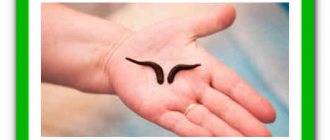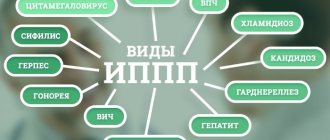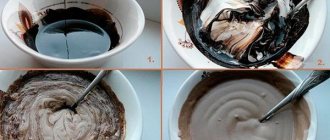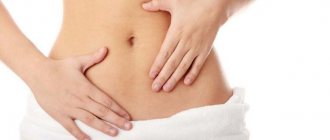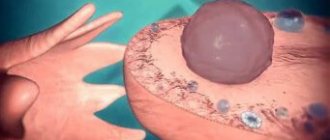Treatment methods
The doctor determines which method of treating the disease will be most effective, taking into account the stage at which it was diagnosed, what reasons contributed to its development, and what the nature of the clinical manifestations is. The acute form of the inflammatory process requires the woman to be in a hospital setting with bed rest.
In the first few days, the patient is prescribed antibacterial drugs, painkillers, sulfonamides and restorative drugs. The subacute form of the disease is treated not only with drugs, but also with physiotherapeutic procedures. Chronic inflammation of the ovaries can be corrected by balneotherapy and other physiotherapeutic techniques.
An acute inflammatory process is treated much faster and easier than a chronic one. In addition, in the latter case, the risk of negative consequences that require other specific therapy increases. Incompletely cured acute inflammation of the ovaries can cause the disease to become chronic.
Causes and symptoms
Oophoritis is always infectious in nature, so the main reason for its occurrence is infection with pathogenic microorganisms through sexual or household contact, as well as after surgical interventions. The disease is accompanied by pain in the lower abdomen and sometimes in the lower back, pathological discharge from the genital tract, and sometimes itching or burning in the vagina. In the acute form of oophoritis, the body temperature may rise, and the woman finds herself bedridden.
In this regard, the main direction in getting rid of the disease will be antibacterial therapy. Along with antibiotics, you can use folk remedies to treat ovarian inflammation to speed up the disappearance of pain and restore the vaginal microflora.
Antibiotics
Only a specialist can determine how to treat inflammation of the ovaries.
As a rule, antibiotics are first prescribed, which help to quickly suppress the inflammatory process. Such medications should be taken only in accordance with the dosage prescribed by the doctor.
Which group of drugs is needed is determined based on the results of a comprehensive diagnosis. To do this, a blood test, gynecological ultrasound, and a test are performed that shows the type of pathogenic microorganism that caused the inflammation. An analysis is also carried out to determine the sensitivity of the pathogen to various types of antibacterial drugs.
It is prohibited to prescribe medications on your own, otherwise you can cause the disease to transition from acute to chronic.
In the treatment of the inflammatory process, drugs of the following groups are used:
- aminoglycosides, which help stop the development of gram-negative bacteria that have increased sensitivity to antibiotics of other groups;
- tetracyclines, which help inhibit the development of foreign cells in the body;
- penicillins, which are allowed to be used even during pregnancy;
- cephalosporins, which help suppress the synthesis of cells of pathogenic microorganisms, have a detrimental effect on both gram-positive and gram-negative bacteria.
In most cases, antibiotics such as Amoxicillin, Cefazolin, Gentamicin, Ampicillin are used to stop the inflammatory process.
Antifungal agents
Such tablets have a detrimental effect only on fungal infections, while they have no therapeutic effect on other pathogens. Antifungal agents are prescribed as additional therapy for ovarian inflammation. This can be explained by the fact that taking massive doses of antibacterial drugs can cause thrush and the development of other fungal infections.
Antifungal drugs used in the treatment of oophoritis (inflammation of the ovaries) include:
- Nystatin (daily dosage - 2,500,000 units, 6-8 times a day for 10 days);
- Amphotericin (daily dosage – 200 mg twice a day for 3 days);
- Nizoral (daily dosage – 200 mg once a day for 3 days).
Side effects of such medications include nausea and vomiting, general malaise, diarrhea, allergic reaction, and dizziness.
Decoctions for inflammation of the ovaries
It is useful to eat pumpkin in any form during the treatment of the disease, as well as drink pumpkin juice. Traditional healers recommend taking chamomile juice for inflammation of the ovaries and other diseases of the genitourinary system. It is enough to drink 1 dessert spoon of healing juice 2-3 times a day before meals.
In addition to this, femoral stonefolia has effective anti-inflammatory properties, from which it is necessary to prepare a decoction:
- Pour 1 large spoon of femoral grass into 1 liter of drinking water;
- Place on fire, bring to a boil;
- Boil over low heat for 10 minutes;
- After time, remove from heat and filter.
You need to add honey to the medicinal decoction and drink throughout the day. The course of taking the remedy takes 7 days. And if the pain does not go away, after a few days of break you can resume taking the decoction.
Treatment of infertility with folk remedies
A decoction of St. John's wort will help get rid of inflammatory processes in the genital organs. To prepare a medicinal potion you will need:
- Grind a tablespoon of St. John's wort and pour boiling water (1 cup);
- Boil over low heat for a quarter of an hour;
- Then remove the broth from the heat and strain.
The product must be taken orally, a quarter glass three times a day.
Herbal decoctions also have a positive effect on the body during illness. Here is the recipe for one of them:
- Chamomile;
- St. John's wort;
- Yarrow;
- Sweet clover;
- Oregano.
Thus, chamomile, in case of inflammation of the ovaries, normalizes the level of estrogen in the blood and improves digestion, and oregano is a strong natural antibiotic, and even with analgesic properties. Sweet clover and St. John's wort protect the body from uterine bleeding.
All herbs should be taken in equal parts and brewed in a thermos with boiling water, based on 1 glass of water - 1 spoon of raw materials. It is recommended to drink the healing decoction up to 3 times a day, half a glass.
Since ancient times, healers have treated women's ailments of an inflammatory nature with thorns. Prepare the decoction like this:
- Pour 5 grams of thorn bark with water, in a volume of 250 milliliters;
- Boil over low heat for a quarter of an hour, and then filter.
It is recommended to drink the prepared drug warm as tea. Traditional healers recommend douching with the same decoction, diluting it with a glass of warm boiled water.
In addition to decoctions, there is another good recipe for treating this ailment. You will need to prepare an ointment; to do this, combine 1 tablespoon:
- ichthyol ointment;
- glycerin;
- camphor oil and iodine.
Mix the compound ointments to a homogeneous consistency and soak a cotton swab. Insert the tampon into the vagina. Treatment lasts for at least two weeks until signs of inflammation completely disappear.
Anti-inflammatory drugs
Inflammation of the ovaries in women is accompanied by various unpleasant symptoms. In this case, anti-inflammatory drugs will come to the rescue. Preference is given to the rectal and vaginal form of release of drugs that have antibacterial, antiviral and antifungal effects.
To relieve pain, you can use pain-relieving suppositories, for example, Diclofenac
Rectal suppositories called Indomethacin are often prescribed. The drug has an analgesic effect and quickly relieves the inflammatory process. Despite the effectiveness of the drug, its use can cause side symptoms: nausea, dizziness, diarrhea, increased anxiety, etc.
The drug Diclofenac is often used as an analogue. Contraindications to the use of the drug are presented only in the form of an increased tendency to hypertension, and side effects do not occur at all. Even despite these advantages, Diclofenac is significantly inferior in effectiveness to Indomethacin.
Another medicine is Movalis in the form of suppositories, which is a non-steroidal anti-inflammatory drug. Effective vaginal suppositories used for oophoritis are Klion D, Terzhinan, Betadine. Only a specialist should prescribe them, because there are many contraindications to their use.
Immunomodulators and vitamins
To increase general immunity and the body's resistance to infectious agents, immunomodulators are prescribed, for example, Anaferon, Cycloferon, Immunal.
Vitamin preparations are used both during the main treatment of the disease and after its completion as preventive and supportive agents. If a malfunction occurs in the monthly cycle, the attending physician may prescribe vitamins E, B, C. Magnesium and vitamin B6 help maintain normal women's health.
Physiotherapy
Physiotherapeutic procedures are prescribed both for acute oophoritis and in the acute stage of a chronic disease (after stopping the main inflammatory process). Such therapeutic measures are carried out both in inpatient and outpatient settings. Initially, the use of external physiotherapy is prescribed, and if there are even minimal manifestations of inflammation, intravaginal ones.
As a rule, for oophoritis, complex physiotherapy is used with several types of manipulations. This can be explained by the fact that each technique has a different effect on a woman’s body, and together they lead to recovery. The most effective are:
We also recommend reading:
How to cure inflammation of the appendages
- electrophoresis with antibiotics, sulfonamides, anti-inflammatory drugs (manipulation is carried out daily for 10 days);
- UHF therapy (manipulation is carried out every day for 10 days);
- DMV treatment (sessions are carried out every day for 10 days);
- infrared laser therapy (course of therapy – 10 days, sessions are carried out daily);
- paraffin therapy (manipulation must be carried out once every 2 days for 10 days);
- treatment with healing mud (sessions are held once every 2 days for 15 days).
Physiotherapy methods include ascending showers and therapeutic baths. The first technique helps improve blood microcirculation in the pelvic organs and metabolic processes in the uterine appendages. As a result, rapid restoration of the affected tissue occurs. Therapeutic baths are carried out with the addition of iodine and bromine, hydrogen sulfide. Such beneficial substances improve metabolic processes, eliminate inflammation in general, and participate in the restoration of damaged tissues.
Despite the effectiveness of physiotherapy, it also has some contraindications, namely: the presence of a malignant tumor in the body, the development of endometriosis, uterine fibroids, uterine bleeding, polycystic testicles (both ovaries).
Electrophoresis helps quickly deliver medicinal substances to the area with inflammation
Cause of the disease
The main reason that causes inflammation is hidden in bacteria that have entered the human body, which can be streptococci, staphylococci, gonococci, chlamydia, E. coli, and tuberculosis virus. The route of entry of the virus into the body runs through the patient’s vagina, then the uterus becomes infected, after which the infection ends up in the fallopian tubes. Thanks to the fallopian tubes, the viral parasite ends up in the paired appendages, exciting the inflammatory process of the ovary.
The weakened immune system of a woman due to pregnancy, menstrual discharge, the postpartum or post-abortion period practically does not resist penetrating pathogenic infections.
However, there are a number of factors that are most conducive to the development of this disease in women:
- stressful situations;
- general body fatigue;
- unstable sleep;
- malnutrition;
- prolonged exposure to the cold;
- poor personal hygiene;
- unprotected sexual intercourse;
- bathing procedures immediately after sex.
The process of inflammation of the ovaries, accompanied by purulent accumulations, can easily provoke peritonitis. This complication occurs due to the entry of purulent discharge into the abdominal cavity, which leads to inflammation of the peritoneum, the membrane that protects a number of internal organs. In rare cases, purulent masses may end up in the colon. In such cases, the ovaries themselves need treatment and measures must be taken to eliminate purulent masses from the patient’s body. Otherwise, there is a fairly high probability of infectious pests multiplying throughout the woman’s body, which will inevitably lead to dysfunction of other important organs.
You should not take this pathology in women lightly, since complications caused by untimely or illiterate treatment can be the most unexpected. In 62-72% of all cases of inflammation of the ovaries of the female genital organs leads to infertility. In half of all cases, sexual desire for a partner noticeably decreases, pain symptoms are felt during sex, and the sensitivity of orgasm disappears. In order to eliminate the possibility of unwanted complications, you should immediately contact a specialist for a full examination and proper diagnosis of the disease in order to promptly begin to treat the emerging disease.
Folk remedies
Inflammation of the ovaries at home can be treated with folk remedies, but only in combination with the main therapy prescribed by the doctor. Folk remedies will help relieve unpleasant symptoms, such as pain. Can be used:
- infusion of cinquefoil (2 tablespoons per 500 ml of hot water; leave for an hour and take 100 ml before meals);
- infusion of blueberry leaves (1 tsp per 200 ml of hot water; leave for 30 minutes, use for douching);
- linden infusion (2 tablespoons of flowers per 500 ml of hot water; leave for an hour and take 5 tablespoons before meals);
- infusion of barberry roots (0.5 tsp of roots per 200 ml of hot water; leave for an hour and take 1 tsp 3 times a day);
- a decoction of centaury, coltsfoot, sweet clover (pour 20 g of raw material into 200 ml of boiling water, simmer for an hour, then take 75 ml at a time 5 times a day);
- decoction of rose hips and black currants (pour 20 g of the mixture into 200 ml of water, simmer for an hour, then take instead of tea).
It is useful to take steam baths with the addition of forest hay and sit over the steam of fresh cabbage boiled in milk.
When is surgery necessary?
If conservative treatment does not bring the desired recovery, surgery is performed. Also, surgical intervention is necessary in case of intractable pain syndrome, with the development of peritonitis due to rupture of the abscess capsule and the threat of abscess breakthrough, with intestinal obstruction.
In the above situations, the operation is performed urgently. Many gynecological specialists agree that first of all it is necessary to preserve the appendages completely or part of them, and, as a result, women’s health (especially in young women). For this reason, radical surgery is performed in extreme cases.
To avoid the need for surgical intervention, it is important to identify the disease at the initial stage, when the chances of a complete recovery using conservative techniques are quite high.
What is ovarian inflammation in women?
Ovarian inflammation is a combined group of infectious and inflammatory diseases. All of them are localized in the tubes of the uterus or ovaries. Inflammation can be unilateral or bilateral. The disease is provoked by pathogens rising up from the cervical canal or fallopian tubes. The mode of infection occurs through blood or lymph. In this situation, the disease can provoke tuberculosis or caries. The symptoms of the pathology are very similar to the manifestations of other diseases. For this reason, a large number of methods are used to diagnose ovarian inflammation. The patient will have to undergo an ultrasound, a smear, blood and urine test.
The disease can occur in acute or chronic form. The pathology is accompanied by a violation of the correct location of the pelvic organs. The ovaries are enlarged. Adhesions may appear. As a result, ovarian cysts often develop in pathology.
Salpingitis and adnexitis are concomitant diseases of ovarian inflammation. In the first pathology, the inflammatory process is localized in the uterine cavity of the tissue of the fallopian tubes. With adnexitis, the appendages become inflamed.
The disease can occur as a result of exposure to pathogenic microorganisms. External factors act as provocateurs. Often inflammation of the ovaries appears as a result of:
- hypothermia;
- abuse of antibiotic or hormonal drugs;
- use of an intrauterine device;
- infectious diseases;
- injuries received during a gynecological examination.


